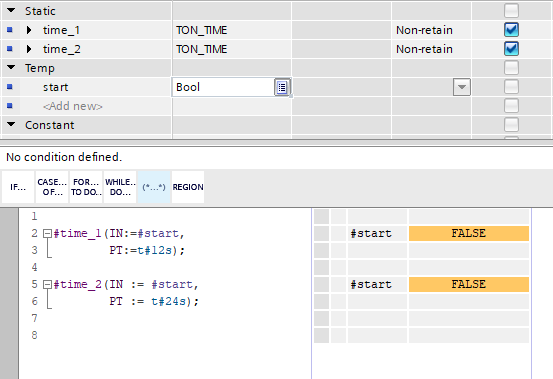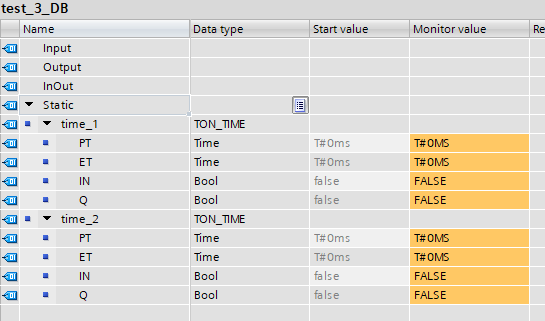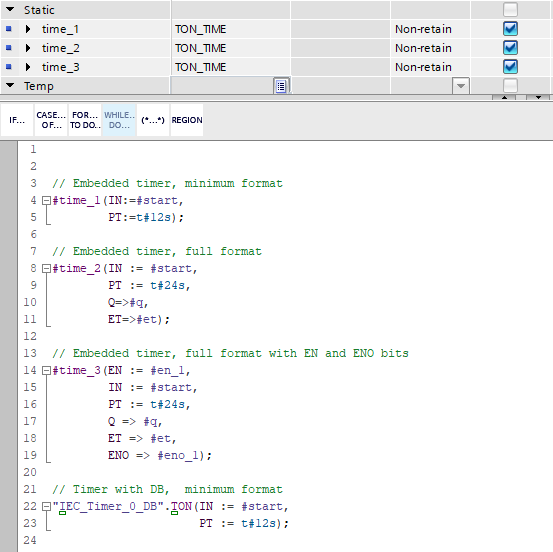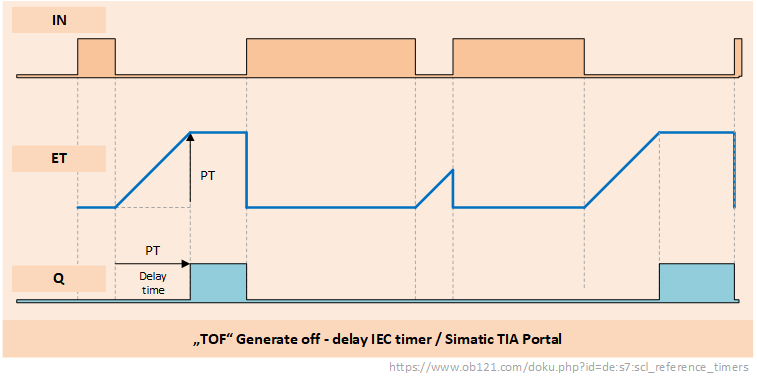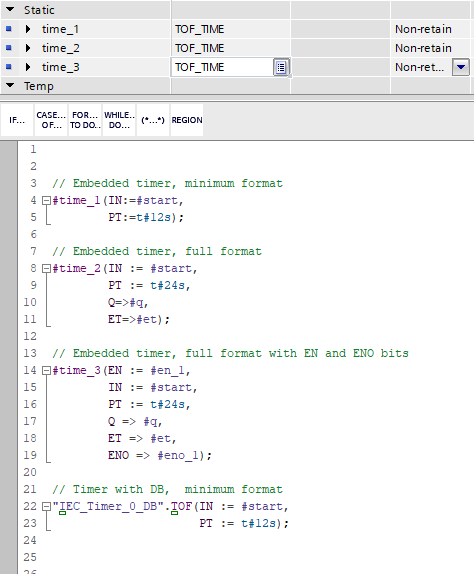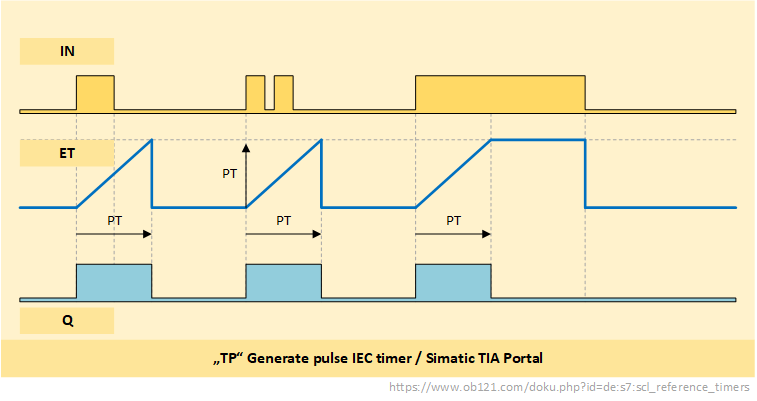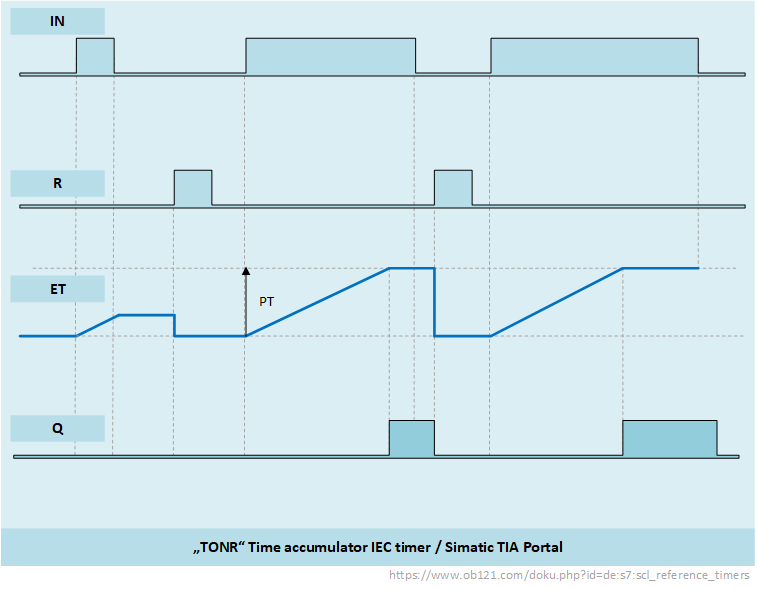Simatic S7 SCL reference: Timers
Back to reference overview: Simatic S7 SCL reference with examples
IEC timers
IEC timers (TP, TON, TOF) should definitely be called embedded from the FBs, the description of which can be found here: Call FBs
In the case of embedding, the functions must be called from the static block of the calling FB (just type TON for the data type):
TON: Generate on-delay
The TON switch-on delay function. It monitors the positive edge of the binary signal at the IN input. If the signal persists for a specified PT time, it outputs Q. The timer is most commonly used to delay signals, for example: - in the case of a field signal, we want to make sure that not only one interference signal is received - in case of level signals we want to get a certain signal (many level signals wobble)
See: Timer operations
TON Examples
CALL TON
TON second impuls
The example program below can be downloaded here: test_ton.scl.
Here is a description of how to import the downloaded program to the TIA Portal: Import source code to the TIA portal.
// author OB121 / Sandor Vamos // ob121.com; 2022.04.13. // TON example: sec impuls // // More information: // https://www.ob121.com/doku.php?id=de:s7:scl_reference_timers // // FB "static" variables: // secTakt: TON_TIME // q, secChange: BOOL // secCount: INT // FB "temp" variables: // tempInt: INT // tempBool: BOOL // TON, as sec impuls generator #secTakt(IN:=NOT(#q), PT:=t#1s); // For example, the "Q" parameter can be called // directly when calling "secTakt", // OR it can be referred to as: #q := #secTakt.Q; // when the time has elapsed, the block will be called: // - secChange changes its status every second // - secCount increases every second, in the range 0..9 IF #q THEN #secChange := NOT (#secChange); #secCount := #secCount + 1; IF #secCount > 9 THEN #secCount := 0; END_IF; END_IF; // monitor #tempInt := #secCount; #tempBool := #secChange;
TOF: Generate off-delay
The TOF switch-off delay function. It monitors the positive edge of the binary signal at the IN input. If the signal persists for a specified PT time, it outputs Q. The timer is most commonly used to delay signals, for example: - in the case of a field signal, we want to make sure that not only one interference signal is received - in case of level signals we want to get a certain signal (many level signals wobble)
See: Timer operations
TOF Examples
TP: Generate pulse
The TP pulse generator function. It monitors the positive edge of the binary signal at the IN input, and generates pulses in effect equal PT length from this. It is commonly used to extend very short-lived signals because, for example, the cycle time of a WinCC HMI is typically 1 sec. If the signals are extended for 2 seconds, the HMI can also process them.
See: Timer operations
| _FB_ TP ( | |||
| IN: BOOL , | input | Start signal: The function monitors the positive edge of this binary signal. The timer start, if signal is first time TRUE. | |
| PT: TIME , | input | Extending time: example: t#12s | |
| Q: BOOL , | output | Result: Q will be TRUE for the duration of the signal extension. | |
| ET: TIME | output | Elapsed time | |
| ); | |||
TONR: Time accumulator
The TONR time accumulator function. It practically collects the times, and if the input signal IN has already existed for the right amount of time, it indicates a result Q. The timer function can be reset with the reset input R to set null the amount of time collected.
See: Timer operations
| _FB_ TONR ( | |||
| IN: BOOL , | input | Start signal: The function monitors the positive edge of this binary signal. The timer running, if signal is TRUE. | |
| R: BOOL , | input | Reset signal: The timer function can be reset with the reset input R to set null the amount of time collected. | |
| PT: TIME , | input | Extending time: example: t#12s | |
| Q: BOOL , | output | Result: After collecting the PT amount of time, the Q output will be TRUE. The function can then be restarted with the R input. | |
| ET: TIME | output | Elapsed / collected time | |
| ); | |||
End of site
Post views: 1488


